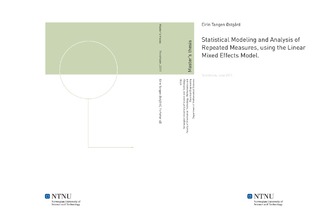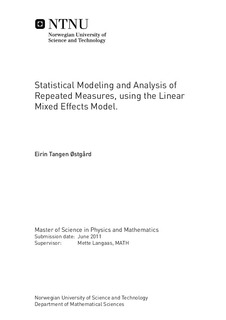| dc.contributor.advisor | Langaas, Mette | nb_NO |
| dc.contributor.author | Østgård, Eirin Tangen | nb_NO |
| dc.date.accessioned | 2014-12-19T13:59:01Z | |
| dc.date.available | 2014-12-19T13:59:01Z | |
| dc.date.created | 2011-08-02 | nb_NO |
| dc.date.issued | 2011 | nb_NO |
| dc.identifier | 432283 | nb_NO |
| dc.identifier | ntnudaim:6004 | nb_NO |
| dc.identifier.uri | http://hdl.handle.net/11250/258888 | |
| dc.description.abstract | Our main objective for this thesis is to present and discuss the linear mixed effects model and, in particular, the different possible covariance structures for the random effects and the residuals. The linear mixed effects model is widely used in biology and medical research.We use data from a diet intervention study where the aim was to investigate the difference between a diet rich in carbohydrates and a diet rich in fat and protein. Data from $32$ participants were available. A series of biomarkers were measured before and after both diets, giving repeated measurements from each participant across time and diet.We have studied different linear mixed effects models varying in covariance structure for the random effects and the residuals. Further, we have focused on a thorough treatment of statistical contrasts. The contrasts of interest in this study are estimates of the effect of the two diets and the difference in effect between the two diets, and is especially relevant to biologists and medical researchers. Statistically, there is no common agreement on how degrees of freedom should be calculated when testing contrasts. We will show that using different parameter coding for a between-subject factor in the same model, yield different results.The linear mixed effects model allows complex structures in correlated data to be modeled, and so it is important to look at the implied marginal variance-covariance matrix to understand the structure. We have calculated the empirical variance-covariance matrix of the data, and compared it to the estimated implied marginal variance-covariance matrix, in an attempt to get a more thorough understanding of the covariance structures for the random effects and the residuals.The estimated implied marginal variance-covariance matrix have also been used to estimate the intraclass correlations.Finally, we have fitted the linear mixed effects model using the Bayesian approach, integrated nested Laplace approximations (INLA), and compared the results to the results of the frequentist approach. | nb_NO |
| dc.language | eng | nb_NO |
| dc.publisher | Institutt for matematiske fag | nb_NO |
| dc.subject | ntnudaim:6004 | no_NO |
| dc.subject | MTFYMA fysikk og matematikk | no_NO |
| dc.subject | Industriell matematikk | no_NO |
| dc.title | Statistical Modeling and Analysis of Repeated Measures, using the Linear Mixed Effects Model. | nb_NO |
| dc.type | Master thesis | nb_NO |
| dc.source.pagenumber | 90 | nb_NO |
| dc.contributor.department | Norges teknisk-naturvitenskapelige universitet, Fakultet for informasjonsteknologi, matematikk og elektroteknikk, Institutt for matematiske fag | nb_NO |

